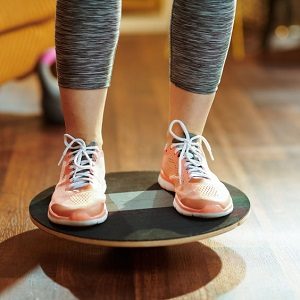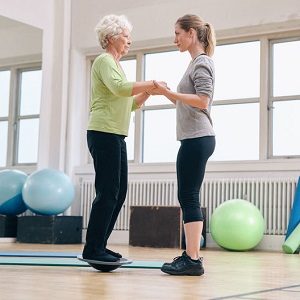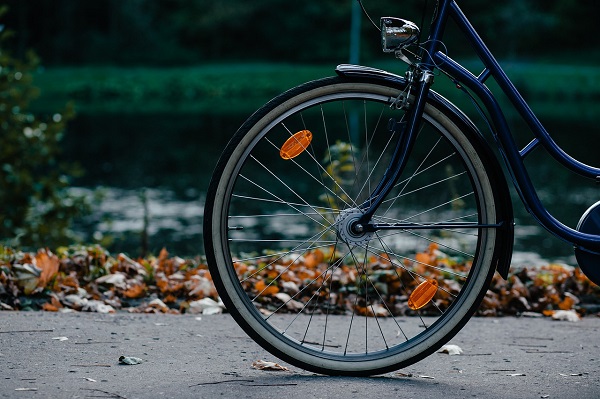Stand on a balance board to improve balance
A balance board, initially patented for entertainment and recreation, is now a legitimate exercise and rehabilitation tool to improve balance for the right people, in the right circumstance. Standing on a balance board and moving with and against the rocking of the balance board can be done safely and easily while having fun at the same time.
Balance is a vital part of everyday life, combining head control, posture and coordination for most day-to-day activities and motion. It is also vital for peak performance in many sports and leisure activities, from skiing down a mountain or controlling a football for a shot on goal to hitting a long, straight drive at golf or back flipping on a balance beam at the Olympics.
What is a Balance Board?
Balance boards, in their simplest form, are a board sitting on a fulcrum, commonly a ball or roller. To use one, you stand on the board on top of the unstable fulcrum and try to balance. Balance is maintained when weight distribution is equal and maintained either side of the fulcrum. To do this well, you need a combination of motor skills and good weight distribution (coordination and core strength) to keep balance without toppling to one side. Using a board helps in training of muscles and also exercises neural networks in the brain. This is good, at any age, to improve balance.
How does Balance work?
The part of the brain affecting balance is the cerebellum. It controls balance, movement and coordination. For the body to maintain balance, it also relies on three sensory subsystems, the vestibular (inner ear), visual (eyes and eyesight) and proprioceptive (nerves, ligaments and muscles) systems. If any of these are damaged or deteriorate your balance can be affected. For more about the physiology about Balance have a look at the Balance Clinic
A balance board is mainly a test of your static balance and trouble on the board could point to a problem that may need further diagnosis. Your static balance is how you maintain control while standing in place, while dynamic balance, or coordination, is the control you have as you move. Looking after neck and back posture is important for balance, especially as we age, but balance can be affected by a variety of factors. A balance board may not be suitable where other factors or underlying health or fitness issues need to be considered.
Types of Balance Boards
There are several types of balance boards and degrees of difficulty to use them. A ‘rocker board’ is limited to left/right or forward/back movement, whereas a round ‘wobble board’ offers 360° movement. The other factor is tilt angle, which is mainly determined by the height and width of the fulcrum compared to the board. The size of the board will affect the speed of movement and the difficulty to control it, as well as what functions and parts of the body you can test out. Either a balance or wobble board would be a useful tool to help improve posture.
Who can use a Balance Board?
For athletes, a balance board is often used as part of a recovery regime after a sports injury. They provide a low impact way to recover balance and movement. They are useful as part of abdominal and trunk strengthening and increasing tone in the quadriceps, hamstrings and calf muscles. After knee surgery such as ligament or cartilage operations, boards can help with ‘re-educating’ the proprioceptive system. Also, if an injury or break has lead to muscle atrophy on one side, a balance board can also add complexity and difficulty in a rehab program to strengthen muscle.
As you age, balance problems are very real and are the major cause of falls and their consequences. Good balance requires both mental and physical fitness. The suitability of attempting a balance board will depend on the symptoms of your balance issues.
3 Tips before using a Balance Board
Carpet Mat: Place your balance board on a carpet or rubberized mat. If you place it on floor boards, or a shiney surface the balance board may run away from you. If you place the balance board on unsealed concrete, the underneath surface will become damaged and flatten.
Footwear / Barefoot: Footwear or barefeet depends on personal choice, your degree of balance, the condition of your feet and the sweatiness of your feet. Wearing a sports shoe will give your foot greater stability and grip. Barefooted will give you more sensory feedback from the plantar surface (sole) of your foot. If you have lost plantar sensation (for example with diabetes) or have lost the fatty padding on the sole of your feet (part of the ageing process) footwear is recommended. If your feet are really sweaty (hperidrosis) you will probably slide off the balance board. Footwear is logical.
No Socks: Socks only on a balance board is not recommended, even if the top of the board has a non-slip surface. Your socks risk gripping the surface while your foot stretches the sock. Your foot will slide sideways, forward or backwards and you find yourself toppling off.
How to get Started:
If you are using a Balance Board at home, on your own, set up your board where you can hang on to a secure surface – a heavy piece of furniture or a wall with a hand rail. Step on to the board, while hanging on. Keep hanging on to the rail and feel the unsteadiness under your feet. If your balance is very poor this will be almost impossible and supervision, or investigation of other issues would be wise. If you can balance slowly loosen your grip on the rail. When you start 30 seconds can feel like a very, very, very long time! That’s ok. Step off, rest, then try again. Over the days and weeks it will get easier.
Your doctor can provide advice, perhaps determining whether you’ll be best served by an osteopath, a chiropractor, physiotherapist or podiatrist to help recovery or pain management in a non-surgical treatment plan … or if you’re free to try a balance board to improve your balance.


